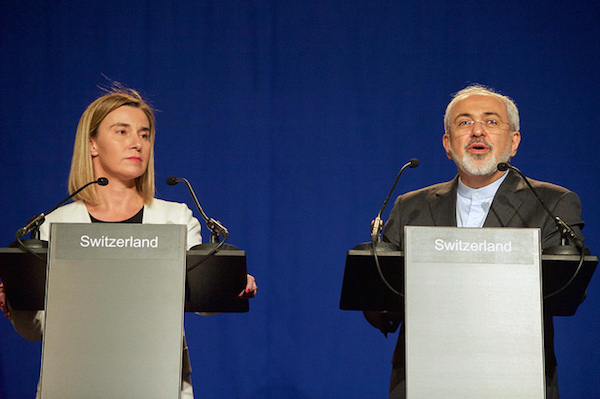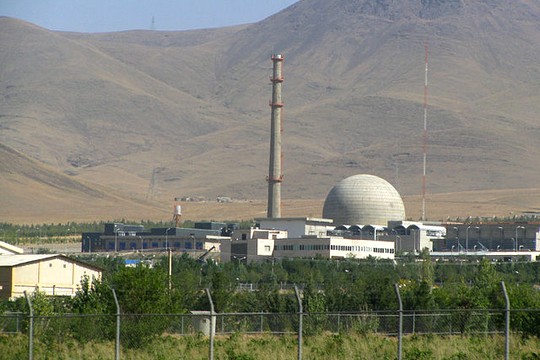Israelis don’t seem to understand that the Lausanne agreement will allow them to maintain nuclear ambiguity, while providing Iran with a last-ditch survival strategy to protect itself from a military strike.
By Shemuel Meir

The framework agreement between Iran and the P5+1 reached in Lausanne came down on Israeli decision-makers and analysts like a lightning bolt on a sunny day. They were expecting failure in the talks and an anemic press release. Instead, the agreement was announced and detailed information was published about its significant technical parameters that will block Iran’s path to the bomb.
Don’t pay too much attention to reports in the Israeli media about an apparent gap between the U.S. parameters documents published and Iran’s statements. The Iranian declarations don’t contradict the Americans when it comes to the technical parameters. The difference of opinion relates to political and strategic issues — the timing and pace at which sanctions will be lifted.
This is not an agreement to temporarily delay Iran’s paths to weaponization, that will allow Iran to do develop nuclear weapons in 15 years if it pleases. It is an agreement with permanent supervision and verification mechanisms that will “fold back” and neutralize the dangerous components that could have been used for developing nuclear weapons. The agreement will end the ambiguity of Iran’s nuclear program and will ratify Iran’s status as “a non-nuclear weapon” state under the NPT. What follows is an analysis of the technical outlines of agreement, which is the best way to understand the Iranian story of the last decade.
The core of the heavy water reactor at Arak will be destroyed and and removed from Iran. All of the used nuclear fuel from a new core, which will produce small amounts of plutonium under international supervision, will be transferred out of Iran. There will be no plutonium separation facility. And therefore, it will no longer be possible to produce compact nuclear warheads that can be fitted on ballistic missiles.
Iran can enrich uranium only in one facility (5,000 first-generation, dated centrifuges from Natanz) to a civilian level of 3.6 percent, for making nuclear fuel for a power plant. The second centrifuge facility in Fordo (the underground facility), where in the past Iran enriched to 20 percent (the fastest way to reach military grade enrichment, or the highest level in Netanyahu’s UN diagram), will shut down and be converted to a research center with international cooperation. Uranium-related activities will not take place at Fordo and the site will remain under IAEA supervision. Iran’s remaining 13,000 centrifuges will be transferred to IAEA custody and some will be used to replace the aging centrifuges in Natanz that tend to break down. The advanced centrifuges will not be used for uranium enrichment for at least 10 years but yet undefined “limited research and development” will be permitted in the advanced centrifuges. There will also be a drastic reduction in the amount of lower-level enriched uranium that Iran is allowed to stockpile: 300 kilograms instead of the 8,000 that made people nervous prior to the deal.
Unprecedented inspection and transparency measures unseen in any other country in the world will be placed on Iran’s low-grade uranium enrichment for civilian purposes. For example, 20-25 years of IAEA inspection on Iranian uranium mines as well as on centrifuge manufacturing and storage facilities. A critical addition to the already existing inspection and of nuclear fuel production in uranium conversion facilities. These are measures that are designed to provide an additional safety belt for the “Additional Protocol” of the IAEA and to prevent the diversion of low-level enriched uranium meant for civilian purposes to parallel secret sites for enrichment to the military grade level necessary for fissile material for a nuclear weapon. Without fissure material, there is no bomb. The main intrusive inspection mechanism to prevent the creation of and stockpiling fissile materials will be the Additional Protocol allowing “any time, any place” IAEA inspections, including at undeclared sites, and with very short notice of mere hours. Despite the emphasis Iran put on the “voluntariness” of the Additional Protocol, it is an obligation FOREVER, as explained by U.S. Energy Secretary Ernest Moniz — who is responsible for the nuclear Los Alamos National Lab and the Lawrence Livermore National Laboratory, and who was a central player in reaching the agreement in Lausanne. Likewise, Iran will sign the IAEA Modified code 3.1, which is an obligation to declare any new nuclear facility from the moment the concept is conceived — and not 180 days before nuclear materials are moved in, as was required under the previous code. The “updated code” will prevent a repeat of the Natanz and Fordo affairs of 2002 and 2009, respectively.
But commentators in Israel have ignored one important point of the Lausanne agreement. The United States and the P5+1 states did not pardon or “acquit” Iran for past suspicions of “possible military dimensions” and research activities on nuclear weapons (until 2003, when U.S. intelligence assessed that work stopped work on nuclear weapons and has not since been renewed). It was established that Iran will implement “a series of agreed-upon steps” relating to past suspicions that were raised in the appended IAEA report of November 2011. Responsibility for addressing past suspicions will be placed in the IAEA’s discreet professional echelons. As I understand it, it will be similar to how violations in South Korea were addressed (attempts at enriching uranium and separating plutonium in a military framework). The South Korean case took four years for the IAEA to issue an exculpatory declaration. At the end of the process, South Korea signed the Additional Protocol in order to prevent recurring violations. It is important to clarify this point because there have been a number of misguided analyses suggesting that addressing past suspicions should be a pre-condition for a final agreement with Iran.
Read more: How Israel can stop a nuclear arms race in the Mideast
The shock and surprise expressed in Israel about the terms of the framework agreement is likely behind the emergency cabinet meeting Prime Minister Benjamin Netanyahu called just hours after the deal was announced. It is entirely possible that Israel’s surprise was a result of the Americans not passing along classifying information in real time, something American spokespeople hinted at recently. In a conference call with military reporters just 24 hours before the agreement in Lausanne was reached, Israeli Defense Minister Moshe Ya’alon predicted that the negotiations would not result in an agreement. In the cabinet meeting, Netanyahu declared that the Lausanne agreement constitutes an existential threat to Israel and will pave a fast-lane for Iran on its way to a nuclear bomb. As if nothing happened in Lausanne, and “the sea is the same sea — Iran is the same Iran.” One did not get from news reports whether the intelligence chiefs shared the prime minister’s assessment in the emergency cabinet meeting.
Netanyahu wanted to strike while the iron was hot. To erase the significance and the positive developments — the neutralization of Iran’s path toward a nuclear bomb — and to put on the record that Iran is continuing its deception. This time, however, he wasn’t able to shape the public discourse with his usual quotes about a bad deal moving Iran even closer to the bomb. Leading analysts emphasized that the framework agreement was actually a good deal.
Since the agreement, and the initial shock in Israel, the talk of the town in Israeli discourse has been the breakout time, should Iran break the agreement, or after it expires. The agreement in Lausanne — without getting into the various timeframes it details — will not allow any situation in which Iran sprints toward a bomb without it being detected within a number of days.
A sprint toward the bomb, or the breakout time, is the shortest period of time apparently needed for Iran to produce the amount of weapon grade enriched uranium for a first bomb with centrifuges in its possession. In other words, how many months does it need to manufacture and stockpile 25 kilograms of uranium enriched to a 93 percent military grade in its centrifuges. This is not a factual number, but an arbitrary theoretical calculation from David Albright’s right-wing think-tank in recent years, predicting “a bomb within weeks to months.” Albright’s publications have gained widespread popularity among the alarmist camp in recent years. He has presented his predicted breakout time as if it were a factual “metric.” In reality, various researchers have reached different conclusions regarding breakout times. But regardless of the differing calculations of what a breakout time constitutes, it is still problematic because it does not predict the time necessary for actually producing an actual nuclear weapon and fitting it on a missile warhead. Getting there requires additional years of research and development.
The concept of “breakout time” was invented by the Right in the U.S. and has become a game of political football among neo-conservative politicians in the U.S. battling President Obama in Congress. The White House has been dragged behind them. From a strategic standpoint, there is little value in calculations of breakout time to a first bomb. The “breakout” state would need to stockpile a large enough amount of fissure material, in addition to maintaining stockpiles for use after a first nuclear test. That is how every state that sought nuclear weapons acted. And that is what increases the chances of early discovery of such activities, within a very short period of time, of any diversion of low-grade enriched uranium from supervised civilian sites to secret military sites for further enrichment. The intrusive inspection mechanisms of the Additional Protocol make fast breakout almost impossible. Additionally, the Aditional Protocol’s inspection mechanisms alongside the U.S.’s intensive satellite surveillance and radiation detection systems mean that an alarm would be sounded almost immediately in any suspected case of uranium enrichment in any sites not under IAEA supervision. Even in that event there is no strategic value to the concept of a “breakout.”

Even after the agreement expires, the inspection mechanism of the Additional Protocol is forever — Iran will not be able to divert low-grade enriched uranium (which it is permitted to have) to (forbidden) military sites without it being known very quickly. Iran knows very well that the U.S. intelligence is watching it closely, and that its military is practically positioned on its borders — the 5th Fleet is in the Persian Gulf and the 6th Fleet is in the Mediterranean. That is the answer to those who ask why Iran stopped its suspected military nuclear activities after the American attack on Iraq in 2003.
And to those who ask what Iran wants. Paradoxically for Israelis, Iranian adherence to the NPT and the P5+1 agreement is, in its eyes, an insurance plan against regime change plots and pre-emptive military strikes. Contrary to the general Israeli understanding, having no nuclear weapons is a survival strategy for the Iranian regime that protects it from military strike.
And about Israel. In the past two years my blog has analyzed the framework of what would constitute a good agreement, as well as the positive consequences of an Iranian-P5+1 agreement for Israel’s security. Particularly, removing the threat of new nuclear-armed states in the Middle East. And preempting a nuclear arms race in the region means that the NPT won’t fall apart, and Israel won’t have to change strategy and go from nuclear ambiguity to open nuclear deterrence, which is never be a stable strategy in the Middle East. There is no chance that the United States would allow a non-NPT member state to preventatively strike an NPT member state. Especially after the permanent accord with Iran is reached.
Shemuel Meir is a former IDF analyst and associate researcher at the Jaffee Center for Strategic Studies at Tel Aviv University. Today he is an independent researcher on nuclear and strategic issues and author of the “Strategic Discourse” blog, which appears in Haaretz. Read this post in Hebrew here.


